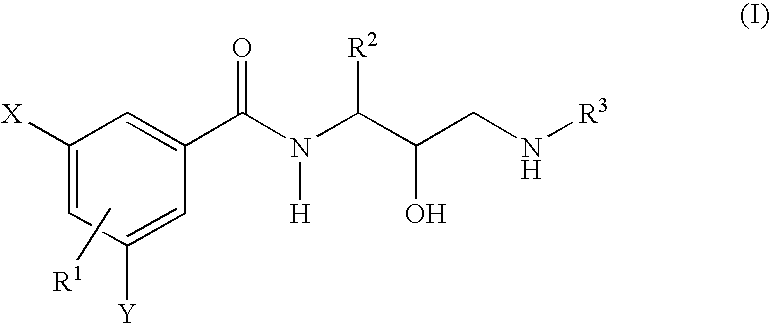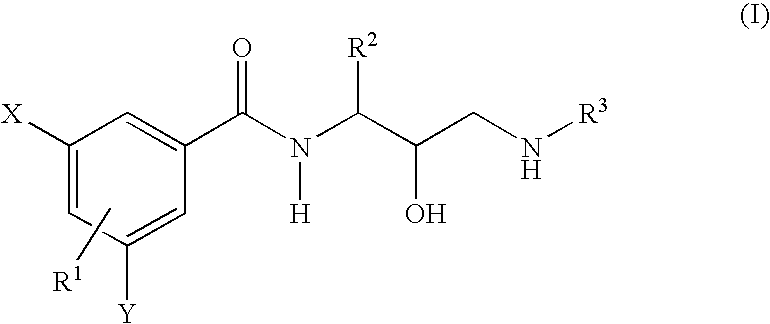Novel phenylcarboxyamides as beta-secretase inhibitors
a technology of beta-secretase inhibitor and phenylcarboxyamide, which is applied in the field of new substituted phenylcarboxyamide, can solve the problems of affecting the productivity of patients and caregivers, the suffering of patients, and the suffering of families, and the cost of alzheimer's disease is enormous
- Summary
- Abstract
- Description
- Claims
- Application Information
AI Technical Summary
Problems solved by technology
Method used
Image
Examples
example 1
N1-((2S,3R)-4-(3-methoxybenzylamino)-1-(3,5-difluorophenyl)-3-hydroxybutan-2-yl)-5-acetyl-N3,N3-dipropylisophthalamide TFA salt
[0080]
[0081] Step 1: Preparation of 3-amino-5-(methoxycarbonyl)benzoic acid. A suspension of 3-(methoxycarbonyl)-5-nitrobenzoic acid (11.25 g, 50 mmol) and palladium on carbon (10 wt %, 1.0 g) in MeOH (10 mL) was shaken in hydrogenator under hydrogen at 50 psi for 3 h. The mixture was filtered and concentrated in vacuo to give the title compound (8.0 g, 82% yield): 1H NMR (CD3OD, 500 MHz) δ ppm 3.91 (3H, s), 7.53 (1H, m), 7.55 (1H, m), 7.92 (1H, m). HPLC retention time: 0.922 min (method A). MS (ESI) (M+H)+196.12.
[0082] Step 2: Preparation of 3-bromo-5-(methoxycarbonyl)benzoic acid. A mixture of copper (II) bromide (5.55 g, 24.9 mmol), n-butyl nitrite (3.21 g, 31.2 mmol) and acetonitrile (90 mL) was stirred in a round bottom flask at 0° C. 3-Amino-5-(methoxycarbonyl)benzoic acid (4.05 g, 20.77 mmol) was added as a slurry in warm aceonitrile (210 mL) over 2...
example 2
N1-((2S,3R)-4-(3-methoxybenzylamino)-1-(3,5-difluorophenyl)-3-hydroxybutan-2-yl)-5-(1-hydroxyethyl)-N3,N3-dipropylisophthalamide TFA salt
[0088]
[0089] Step 1: Preparation of tert-butyl 3-methoxybenzyl((2R,3S)-3-(3-(benzamido)-5-(1-hydroxyethyl)benzamido)-4-(3,5-difluorophenyl)-2-hydroxybutyl)carbamate. tert-Butyl 3-methoxybenzyl((2R,3S)-3-(3-acetyl-5-(benzamido)benzamido)-4-(3,5-difluorophenyl)-2-hydroxybutyl)carbamate (20 mg, 0.0282 mmol) was dissolved in MeOH (0.2 mL) and sodium borohydride (1.43 mg, 0.0378 mmol) was added. The reaction mixture was stirred at room temperature for 2 h. The mixture was concentrated and partitioned between ethyl acetate and H2O. The organic layer was separated and purified by reverse phase prep HPLC to give the title compound (15 mg): 1H NMR (CD3OD, 500 MHz) δ ppm 0.71 (3H, t, J=5 Hz), 1.02 (3H, m), 1.45-1.47 (12H, m), 1.54 (2H, m), 1.74 (2H, m), 2.85 (1H, m), 3.09-3.18 (3H, m), 3.28 (1H, m), 3.49 (2H, m), 3.72-3.81 (4H, m), 3.97 (1H, m), 4.29 (1H, m...
example 3
N1-((2S,3R)-4-(3-methoxybenzylamino)-1-(3,5-difluorophenyl)-3-hydroxybutan-2-yl)-5-((E)-1-(methoxyimino)ethyl)-N3,N3-dipropylisophthalamide TFA salt
[0091]
[0092] A mixture of tert-butyl 3-methoxybenzyl((2R,3S)-3-(3-acetyl-5-(benzamido)benzamido)-4-(3,5-difluorophenyl)-2-hydroxybutyl)carbamate (20 mg, 0.0282 mmol) and methoxyamine hydrochloride (4.71 mg, 0.0564 mmol) in ethanol (0.2 mL) was heated at 80° C. for 2 h. The reaction mixture was purified by reverse phase prep HPLC to give the title compound (10 mg): 1H NMR (CD3OD, 500 MHz) δ ppm 0.73 (3H, m), 1.03 (3H, m), 1.56 (2H, m), 1.76 (2H, m), 2.25 (3H, s), 2.86 (1H, dd, J=10, 15 Hz), 3.08 (1H, m), 3.16-3.22 (3H, m), 3.39 (1H, dd, J=5, 15 Hz), 3.50 (2H, m), 3.81 (3H, s), 3.98 (1H, m), 4.02 (3H, s), 4.21-4.28 (3H, m), 6.77 (1H, m), 6.91-6.94 (2H, m), 6.98 (1H, m), 7.06 (1H, d, J=5 Hz), 7.09 (1H, m), 7.34 (1H, m), 7.56 (1H, m), 7.82 (1H, m), 7.96 (1H, m). HPLC retention time: 2.027 min (method A). MS (ESI) (M+H)+639.50.
PUM
 Login to View More
Login to View More Abstract
Description
Claims
Application Information
 Login to View More
Login to View More - R&D
- Intellectual Property
- Life Sciences
- Materials
- Tech Scout
- Unparalleled Data Quality
- Higher Quality Content
- 60% Fewer Hallucinations
Browse by: Latest US Patents, China's latest patents, Technical Efficacy Thesaurus, Application Domain, Technology Topic, Popular Technical Reports.
© 2025 PatSnap. All rights reserved.Legal|Privacy policy|Modern Slavery Act Transparency Statement|Sitemap|About US| Contact US: help@patsnap.com



